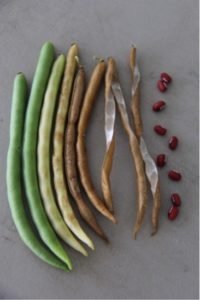Snap Bean Seed Production: Quick Reference - Organic Seed Alliance

Snap Bean Seed Production
Snap beans are a warm season, frost tender annual that prefer fertile loams, but are tolerant of many soil types. They have a high phosphorus demand, and yields will be reduced if it is lacking. Plants may mature less quickly if limited by zinc. Since beans are not efficient nitrogen fixers, they should be inoculated with the correct Rhizobium species and may even need nitrogen supplements for optimal growth. Soils should be well drained but have a good enough water holding capacity to prevent the beans from drying out. Since some beans require a long season, they should be planted early in the season in soils that warm quickly. Crusted soils may inhibit seedling growth. Snap beans germinate best when soils are at least 65°F, and optimum plant growth occurs at temperatures 70-85°F. Direct seed 6-8 seeds per foot in rows that are 24-30 inches apart. For maximum yields, maintain weed-free plots, especially within the row.
Air temperatures below 50°F or above 90°F during flowering will significantly reduce yields. Most beans are day-neutral and flower due to physiological readiness rather than changes in day length. Snap beans are self-pollinating, with the occasional outcrossing due to heat stress or abundant pollinator activity. Isolate varieties 100-150 feet from each other.

On a single plant, snap beans will mature over an extended period of time. Harvesting too early can result in unviable seed, and harvesting too late can result in major losses to pod shattering. Ideally, wait until 70-80% of the pods are a yellow, light gold, or mahogany color, and before the pods become brittle and papery and shatter, releasing the seeds. Cut and leave the plants in the field for one day before raking them into windrows and allow them to cure and dry for 1-2 weeks. Turn plants every few days to encourage even drying.
For large fields (more than 2 acres) use an axial flow combine designed to gently thresh the crop. For fields smaller than 2 acres, gather the windrowed beans onto a large tarp and layered 6-12 inches deep. Make sure the seed is dry and firm before processing. Carefully drive over the plants with a pickup truck or tractor to shatter the pods (make sure to do this on grass or other forgiving surface, not on a hard gravel or concrete surface that can result in damaged and crushed seed). For very small plots, gently walk or dance on the plants. The fleshy pods of snap beans may require extra threshing effort. After the seeds are removed from the pods, use a garden rake to scalp the lighter stem/leaf/pod material up and away from the seeds and throw into the compost. Use a combination of winnowing and screening to remove large debris. Use an air screen cleaner to remove smaller debris that are difficult to separate. Seed dried to 5% or less moisture and stored at 40-60°F and 40%RH or less can be stored for 2-4 years without loss of viability.
Selection and Variety Improvement
Since snap beans are primarily self-pollinating most quality and production characteristics can be evaluated and selected for at any time. At pod and bean maturity, select for bean color and patterning; pod shape, length and color; pod placement on the plant; and duration of yield.
| Trait | Timing |
| Plant vigor | Anytime during growing season |
| Insect resistance | Anytime from flowering until harvest |
| Disease resistance | Anytime from flowering until harvest |
| Plant uniformity | Anytime from flowering until harvest |
| Fresh pod shape | At harvest or soon after |
| Fresh pod length | aAt harvest or soon after |
| Degree of roundness | At harvest or soon after |
| Days to maturity | At harvest |
| Harvest window | At last harvest |
| Frost tolerance | After first frost or beyond |
| Ease of picking | At harvest |
| Fresh yield | At harvest |
| Flavor | Within one week after harvest, or months later if beans were frozen/canned/pickled |
| Texture | Numerical rating/description |
| Tenderness | Numerical rating/description |
Disease
Grow disease resistant varieties. Use a minimum of 3-year crop rotation. Maximize air movement with wide rows and in-row spacing. Remove any and all diseased plants from the field. Minimize work in the field if foliage is wet and avoid overhead watering. If you must use overhead watering, do it in the morning. Clean your equipment between fields. Harvest early maturing pods for seed since diseases often come on later in the season. Diseases are classified by severity with a class of 1 being the most severe and 3 the least severe.
| Disease | Type | Severity class | Favorable conditions |
| Bean common mosaic virus (BCMV) | Seedborne | 1 | |
| Anthracnose (Colletotrichum spp.) | Seedborne | 1 | Wet and moderate temperatures |
| Bacterial wilt (Curtobacterium flaccumfaciens pv. flaccumfaciens) | Seedborne | 1 | Hot and dry conditions |
| Bacterial brown spot (Pseudomonas syringae pv. syringae) | Seedborne | 1 | Wet and cool conditions |
| Common bacterial blight (Xanthomonas campestris pv. phaseoli) | Seedborne | 1 | |
| Halo blight (Pseudomonas syringae pv. phaseolicola) | Seedborne | 1 | Wet and cool conditions |
| Alfalfa mosaic virus (AMV) | Seedborne | 2 | |
| Southern bean mosaic virus (SBMV) | Seedborne | 2 | |
| Cercospera leaf blotch (Cercospera canescens) | Seedborne | 2 | |
| Angular leaf spot (Phaeoisariopsis griseola) | Seedborne | 2 | |
| Leaf and pod blight (Phoma exigua var. exigua) | Seedborne | 2 | |
| Gray mold (Botrytis cinerea) | Seedborne | 3 | |
| Charcoal rot/Ashy stem blight (Macrophomina phaseolina) | Seedborne | 3 | |
| Rust (Uromyces phaseoli typica) | Foliar | ||
| Mexican Bean Beetle (Epilachna varivestis) | Insect | ||
| Bean Weevil (Bruchus obtectus) | Insect |
Control measures for all bean diseases
- A minimum 3-year rotation before planting again
- Maximize air movement with wide row and in-row spacing
- Remove diseased plants from field
- Avoid working in field when the foliage is wet
- Avoid overhead watering if possible. If necessary, then overhead in the morning
- Maintain clean equipment to prevent soil and plants from moving from one field to another
- Harvest early-maturing pods for seed, i.e. don’t wait to harvest later pods only
This resource was made possible thanks to the Montana Department of Agriculture’s Specialty Crop Block Grant Program.

